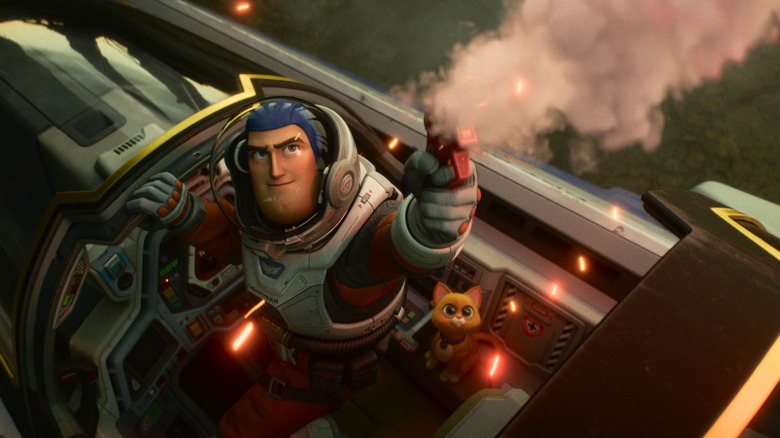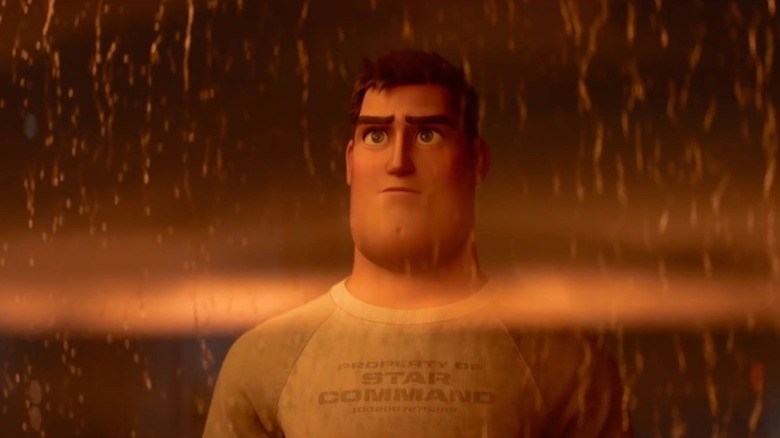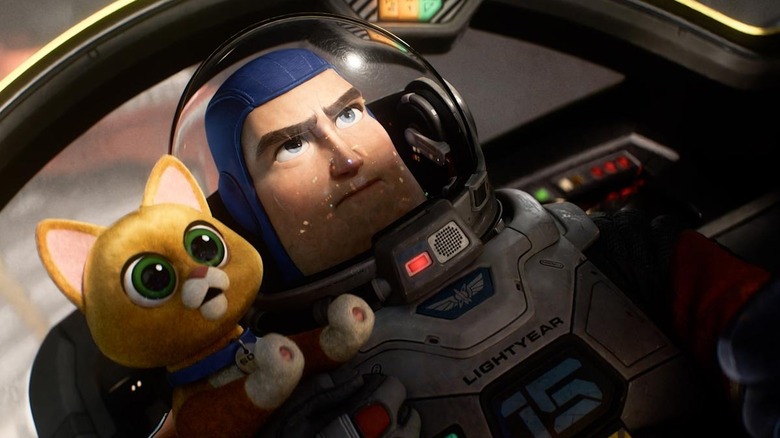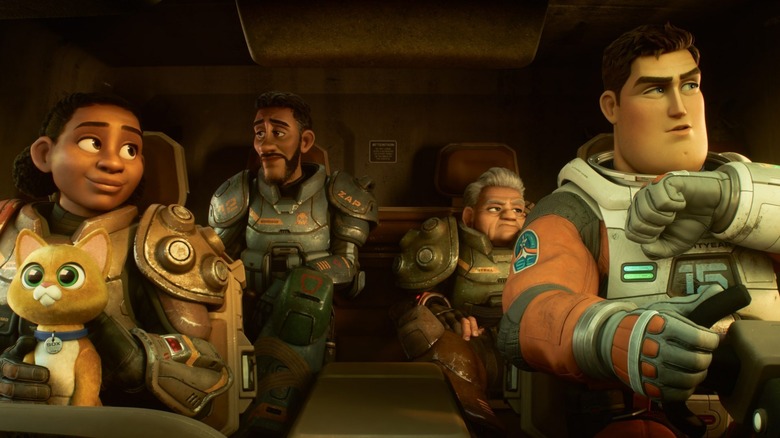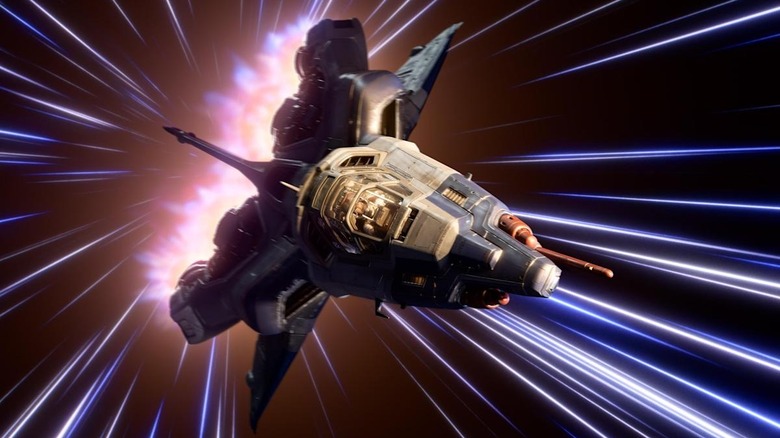Lightyear Director Angus MacLane And Producer Galyn Susman On Metanarrative And More [Interview]
Director Angus MacLane and producer Galyn Susman have been heavily involved in numerous Pixar projects going back decades. Susman's first credit as an associate producer came with "Ratatouille" in 2007, and she later produced several Pixar shorts and TV specials. Her first credited feature as a producer was for "Toy Story 4," and she returns to that role again now for "Lightyear." MacLane, meanwhile, got his start at Pixar as an animator on "A Bug's Life" and "Toy Story 2." He was the animation director on "WALL-E" and animation co-director on 2016's mega-hit "Finding Dory." "Lightyear" marks MacLane's first time as a feature writer and director.
"Lightyear" is a film lifted out of the universe of "Toy Story," standing as the movie that Andy (the human protagonist of "Toy Story") watched and became obsessed with, leading to his love of the Buzz Lightyear toy. The film itself is a wholesome sci-fi adventure story with the usual trappings of spacesuits, faster-than-light travel, ray guns, alien robots, and the like. Laying over the top of everything, however, is the unusual metanarrative that we're seeing a movie that emerged, in its whole form, from a fictional universe.
MacLane and Susman sat down with /Film to talk about the film's unusual conceit, what genre it belongs to, and how "Lightyear" stands apart from all previous Pixar movies.
This interview has been lightly edited for brevity and clarity.
'There's definitely aspects of Buzz that we needed'
The most fascinating thing about "Lightyear" is its metanarrative: It's a film from within the "Toy Story" universe. Was there ever a point in production when this was going to be something more than a space adventure? Perhaps an attempt to make references to what the world of "Toy Story" was like in the 1990s when Andy might have seen it?
MacLane: No. I always saw it as like a way in to tell us a sci-fi action movie. The metanarrative is a launching point for the film. The development of that was a lower priority for us than trying to get the movie to work for all of the challenges that making a movie presents you with, if that makes sense.
The character of Buzz Lightyear was previously established, but this is a new version of him. Were you free to start completely fresh, or do you feel beholden to what had been established (apart from visual things and catch phrases)?
Susman: Both. There's definitely aspects of Buzz that we needed. We wanted to retain — you get a bit of a sense of what his backstory is just from what's written on the back of his box and what we see in the beginning of the first "Toy Story." But Buzz is a side character, really. Those are Woody's stories more than they are Buzz's stories. So he is a little bit more of a comic relief character, a little bit of a doofus. With "Lightyear," he's now the leading man, he's our hero. He needs to be a more well-rounded, fully-formed character. You have to add conflict and self-reflection and all the things that you would expect out of a main character. So that was all open fertile territory for us to do what we thought right.
'Let's look at thrillers throughout history'
It seems that, essentially, Buzz was defined by ad copy. With such a broad sci-fi canvas, what sort of classic tales did you draw from? I got a lot of "Forbidden Planet" from your movie. Was there a template you decided to draw from? Was it a "Star Trek" story? Was it more like "Star Wars?" What were your sci-fi ideas?
MacLane: I would say we didn't go back and specifically look at science fiction as a reference point for the movie or the narrative. Rather, that's a thing that we've been excited about. We kind of let that wash over us and go, "What have we learned or distilled from that through our whole lives?" It's not like we're patterning it after, like, "See what they did here? Let's do that!" It was more like, "Let's look at thrillers throughout history and figure out the structure of thrillers."
Because the visual look of the film is an amalgam of just design sensibilities that I'm excited about. It was like, "This would be cool. This would be the neatest way to do it." Just sensibility-wise, that's all you have going forward. It wasn't like, "Oh, see what they're doing here?" You just know that stuff. I know what I was looking for there. I didn't really need to go back to that. But it was thrillers and the investigation of the genre of thriller and how that structure pulls the audience along and spits them out at the end that we focused on.
'It's a movie inspired by movies'
Pixar's work in general tends to take place in the real world. "Lightyear" is very far removed from that. There's references to humanity, but I don't see references to anything recognizable. It's a completely speculative future.
MacLane: Yeah. I mean, I think I would slightly adjust that and say, usually Pixar movies take place in a world with humans. And I would say the exception is there are no humans in the world of "Cars." For example, "A Bug's Life" has humans in that world. And so in my mind, "Lightyear" exists in a world — it's just a fictitious story that takes place in the future. First and foremost, it's a movie movie like "Raiders of the Lost Ark" is a movie movie. It's a movie inspired by movies. And so this is very much a similar thing. But they're humans, so all stories have artifice because they're constructed stories. My mind doesn't separate that in that way. So ... it wasn't really a concern of mine, I guess. [laughs]
The genre's get-ability
Not to intellectualize, but "Lightyear" does seem to stand very far apart from a lot of the other Pixar films I've seen. Comparing it to your "Toy Story" short "Small Fry" — about Happy Meals toys, which are objects many humans can relate to — "Lightyear" is now wholly fictitious.
MacLane: Well, one thing I would say about that is when you're dealing with sci-fi and like a fantastic world, you need to have something you can relate to. So if you start the movie and you're like, "In the beginning, there was the Kree/Skrull wars...", you're like, "OK, I've got to chew in a bunch of mythology." And then you're like, okay, I got to chew in a bunch of mythology. And so getting into the film, we needed to really establish, this guy is working a job, they're doing this thing. It goes wrong. For all of the fantastical elements, the planet is both alien, and yet you know that it has a spectrum of light that we can see.
Like, there a level of "get-ability," or "I get it!" They're wearing space suits that you don't have to explain. So even though it is fantastical, it has some things that you're taught or can understand narratively so that you can [say] "Okay, tell me what's the next thing." And so, boiling it down to simple emotional ideas helps you understand the more fantastical elements easier.
"Lightyear" opens in theaters on June 17, 2022. It stars Chris Evans as Buzz Lightyear, Josh Brolin as the evil Emperor Zurg, as well as Keke Palmer and Taika Waititi.
